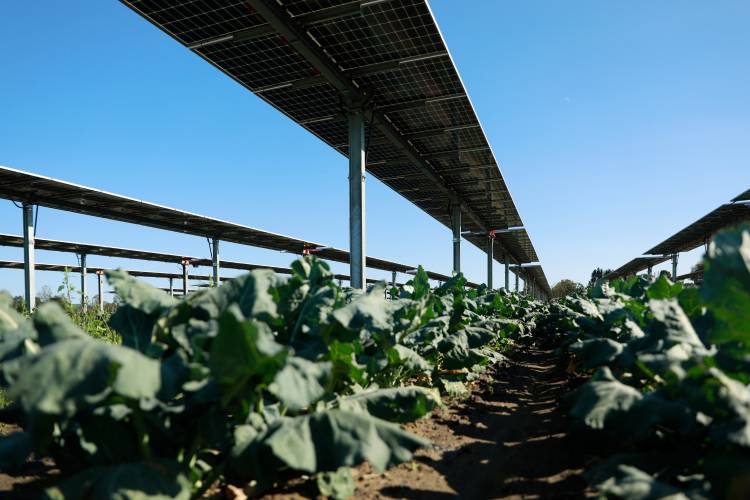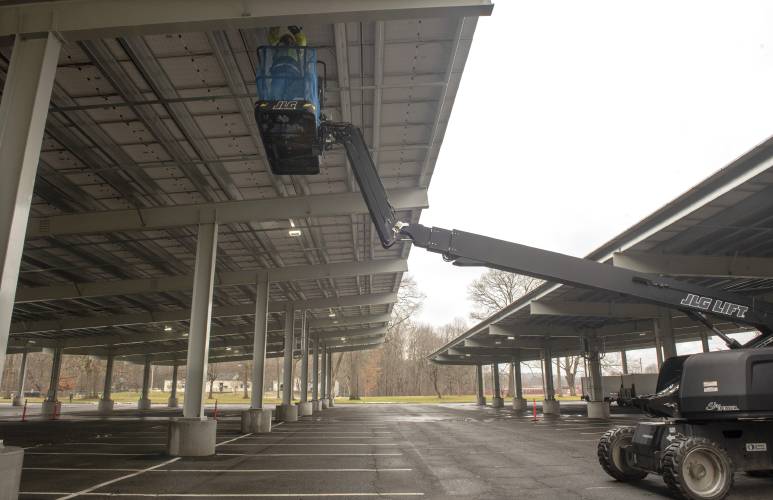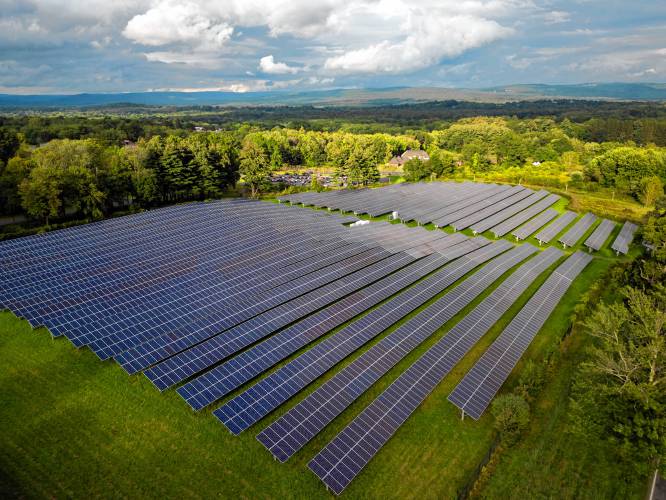The State of Solar: In a final forum at UMass, experts debate best ways to implement solar projects
| Published: 01-03-2024 4:04 PM |
Editor’s note: This is the fourth and final article from the Western Mass. Solar Forum series. The first three forums took place in September, and another series of forums is in the works for this spring.
AMHERST — Most experts agree solar energy is key to reaching the state’s climate goals, but opinions often differ widely when it comes to developing and implementing solar.
Many argue that the built environment, including parking lots and rooftops, presents the least environmentally invasive avenue for solar development, but it can be costly and inefficient. Meanwhile, farmland comprises readily usable land for solar panels with cost benefits for farmers, but has drawbacks for crop production. And while forested land makes up most of the state, with ample opportunities for development, trees and forests themselves are instrumental in supporting carbon sequestration, wildlife habitat, air quality, clean water and more.
In the meantime, historically marginalized and low-income communities are presented with far fewer opportunities to reap the benefits of solar energy than their wealthier counterparts; municipalities struggle with outdated state laws and face legal challenges from developers; and infrastructure remains overburdened to meet a growing demand for solar.
All of these topics and more were bandied about by a panel of stakeholders who gathered on Dec. 19 for the fourth and final Western Massachusetts Solar Forum. Organized by UMass Clean Energy Extension, Sen. Jo Comerford, Rep. Mindy Domb, and other interested parties, the forums were designed to share different perspectives on solar potential, land use, benefits and drawbacks. The first three forums in the series were held in September, with the fourth postponed due to technical difficulties. A second series of forums is expected to take place this spring.
“We have invited people who represent different perspectives on solar energy ... so that we can actually hear how people differ, but also maybe where people are the same, where is the common ground, and also where’s the places that we have to work harder to get to common ground,” said Rep. Domb, moderator of the event.
The previous forums delved into the potential for solar to meet state climate goals and energy needs, challenges in siting solar developments, and solar equity issues. Speakers at the most recent forum included legislators, legal experts, small and large-scale solar developers, landowners, municipal officials, and representatives from solar organizations.
The Massachusetts Clean Energy Plan outlines ways to achieve net-zero statewide greenhouse gas emissions by 2050.
Article continues after...
Yesterday's Most Read Articles
 Idaho woman arrested on charges in 2023 Orange fraud case
Idaho woman arrested on charges in 2023 Orange fraud case
 Phillipston Selectboard confirms no interest in dam
Phillipston Selectboard confirms no interest in dam
 Orange Sewer Commission votes to increase rates
Orange Sewer Commission votes to increase rates
 Protesters oppose Heritage Foundation President Kevin Roberts as Thomas Aquinas College commencement speaker in Northfield
Protesters oppose Heritage Foundation President Kevin Roberts as Thomas Aquinas College commencement speaker in Northfield
 Quabbin towns call for better state support for what they do to protect Boston-area drinking water
Quabbin towns call for better state support for what they do to protect Boston-area drinking water
 Sportsman’s Corner: Our Waters event at Silver Lake
Sportsman’s Corner: Our Waters event at Silver Lake
“All resources that can help us meet decarbonization should be a part of our solution,” said Rep. Jeff Roy, chair of the Joint Committee on Telecommunications, Utilities and Energy. “Solar is very much a part of that solution.”
Roy added that the Massachusetts 2050 Decarbonization Roadmap identifies a need for between 27 and 34 gigawatts of solar energy.
In response to those goals, the Department of Energy Resources set out to quantify solar potential across the state, with findings now included in the Technical Potential for Solar Study, which has been discussed throughout the solar series.
According to the study, Massachusetts has 15 to 18 times the amount of solar potential it needs to support decarbonization requirements, presenting the state with an opportunity to balance the need for solar with natural resource and land protection.
One of those balancing acts has to do with farmland.
“Farms are in a unique position to contribute to renewable energy deployment, carbon sequestration and food security,” said Massachusetts Department of Agricultural Resources Commissioner Ashley Randle. “However, at the department, we recognize that there are trade-offs, particularly between agricultural land production and solar needs.”
Agrovoltaics, or dual-use solar — which refers to solar energy production and agricultural production on the same piece of land — presents farmers with a path for potential revenue diversification and stability in the face of climate change, while simultaneously generating clean energy for the grid.
“The trade-offs to consider when it comes to potential dual-use solar development on farmland include crop suitability, reduced crop production, reduced solar production, [with] solar generation often at the expense of crop production,” Randle said.
Margaret Christie, special projects director at the Community Involved in Sustaining Agriculture (CISA), said that her concern with agrovoltaics is that, as of now, it isn’t possible to do high-volume food production under solar panels.
“We have to figure out how we help people put solar on their marginal land, put solar on their buildings, put solar on the edge of their farm roads, but not put it on the best farmland,” Christie said. “We have some of the best farmland in the world here in the Connecticut River Valley, but we don’t have very much of it.”
Cinda Jones, president of W. D. Cowls, the largest private landowner in Massachusetts, is a large-scale solar host landowner. While Jones agreed with many other speakers at the forum that solar development on built environments — like rooftops, parking canopies, and other buildings — should be incentivized and prioritized, she said, “We need to get realistic about solar siting in western Mass.”
“Towns are ninety-percent forested out here, and they have not a lot of parking lots or rooftops. Most of Western Mass is rural,” Jones said. “Patches of solar in the forest is the only way to go.”
“We need conserved land and we need ground-mounted solar. We can do this simultaneously,” she said. “I consider the best practices to be partnering with agriculture and pollinators, appreciating that 98 percent of a solar site is thriving environmentally under the solar panels; there’s only 2 percent covered by solid posts.”
Kelley Fike, director of civil engineering at Nexamp — a Boston solar company — said that when it comes to large-scale solar development, it is important to listen to community members.
“Every single set of plans I review, I think about neighbors’ views and what they might think when they look out their window or drive past the solar site,” Fike said, adding that at a municipal meeting, a resident proposed planting flowers beneath the solar project, which has now grown into a successful initiative at Nexamp across its projects.
Municipalities face their own set of obstacles when it comes to solar development, according to Michael DeChiara, chairman of the Planning Board in Shutesbury, who pointed to a solar exemption in the state’s zoning regulations under Massachusetts General Laws. The exemption was created in 1985, when commercial photovoltaics were not an option, and DeChiara argued that it should be modified or eliminated.
“The law is totally outdated at this point… and what the law effectively says is that municipalities cannot unreasonably regulate solar with the exception of public health, safety and welfare,” DeChiara said.
In the area, Shutesbury’s solar bylaw was rejected by the state attorney general’s office in November, parts of Pelham’s bylaw were stricken by attorney general, and Leverett’s bylaw is being challenged in Land Court.
“The problem is, in my opinion, in order to prove that a regulation is consistent with public health, welfare and safety, you have to go to court,” DeChiara said, adding that towns will do everything they can to avoid being sued. “All it takes is a developer coming in with lots of money and lots of lawyers to say, ‘We don’t like your regulation and we’re going to sue you.’”
As a result, towns and cities that want to be team players in solar are effectively prevented from meaningfully participating because if they try to participate, they are threatened to be sued, DeChiara said.
Another legislative challenge shared at the forum by multiple speakers had to do with a backlog of solar legislation at the state Department of Public Utilities.
“The DPU backlog is holding hostage this important legislation to rapidly increase adoption of renewable energy in the commonwealth,” said Claire Chang, co-owner of Greenfield Solar. “We in western Mass. have the land and space for homes and farms to potentially generate all of their electricity needs onsite ... We need to put pressure on the governor and the DPU to move the climate bill into reality.”
In another DPU barrier, Fike of Nexamp said the major program driving solar development, the SMART Program, is currently “bogged down in regulatory proceedings” at the DPU, preventing solar companies from thinking forward about greenhouse gas reduction programs.
“Low-income residents have traditionally had less access to solar, but have been left with covering a larger share of the electric grid,” said Rep. Roy. “As more people with higher incomes net-meter after installing solar on their homes, as was the case in California, equity and access to solar will be crucial.”
One way to address solar inequities is through community solar programs, in which a number of individuals share the clean energy benefits and savings of a single solar system. Community solar is typically shared by people with low or moderate incomes, renters, and other people who cannot install rooftop solar.
Steph Speirs, co-founder and CEO of the community solar company Solstice, said, “A ton of people are locked out of rooftop solar, and community solar gives people access to clean energy without forcing them to pay an upfront cost.
“It’s seen as one of the best ways to increase access to people who have been historically locked out of solar, like communities of color, energy communities that are transitioning from fossil fuels, and low-income communities.
Maddie Fabian can be reached at mfabian@gazettenet.com.









 Exhibit opens on Opal Clark’s community service in Phillipston
Exhibit opens on Opal Clark’s community service in Phillipston